engine coolant DODGE GRAND CARAVAN 2015 5.G User Guide
[x] Cancel search | Manufacturer: DODGE, Model Year: 2015, Model line: GRAND CARAVAN, Model: DODGE GRAND CARAVAN 2015 5.GPages: 164, PDF Size: 22.27 MB
Page 101 of 164
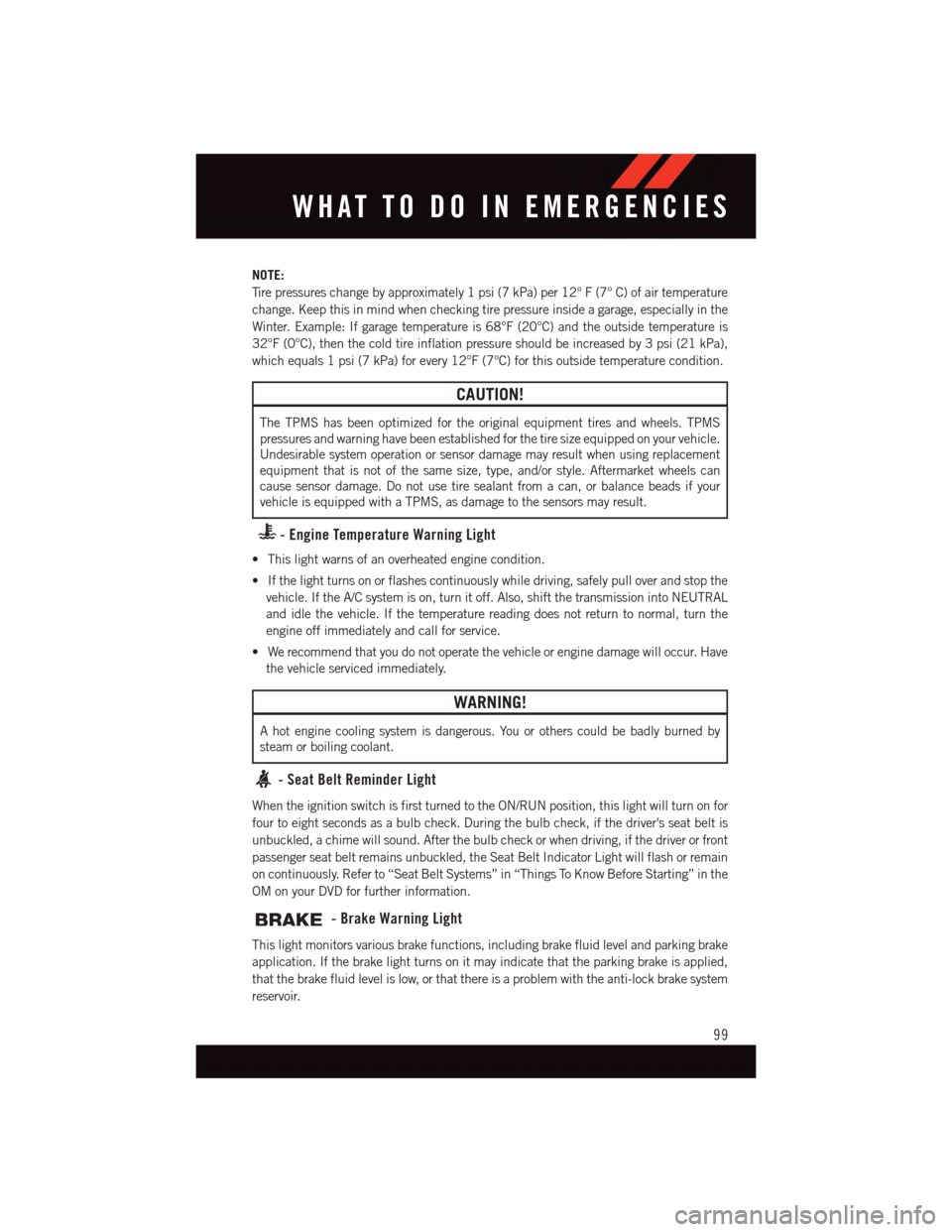
NOTE:
Ti r e p r e s s u r e s c h a n g e b y a p p r o x i m a t e l y 1 p s i ( 7 k P a ) p e r 1 2 ° F ( 7 ° C ) o f a i r t e m p e r a t u r e
change. Keep this in mind when checking tire pressure inside a garage, especially in the
Winter. Example: If garage temperature is 68°F (20°C) and the outside temperature is
32°F (0°C), then the cold tire inflation pressure should be increased by 3 psi (21 kPa),
which equals 1 psi (7 kPa) for every 12°F (7°C) for this outside temperature condition.
CAUTION!
The TPMS has been optimized for the original equipment tires and wheels. TPMS
pressures and warning have been established for the tire size equipped on your vehicle.
Undesirable system operation or sensor damage may result when using replacement
equipment that is not of the same size, type, and/or style. Aftermarket wheels can
cause sensor damage. Do not use tire sealant from a can, or balance beads if your
vehicle is equipped with a TPMS, as damage to the sensors may result.
-EngineTemperatureWarningLight
•Thislightwarnsofanoverheatedenginecondition.
•Ifthelightturnsonorflashescontinuouslywhiledriving,safelypulloverandstopthe
vehicle. If the A/C system is on, turn it off. Also, shift the transmission into NEUTRAL
and idle the vehicle. If the temperature reading does not return to normal, turn the
engine off immediately and call for service.
•Werecommendthatyoudonotoperatethevehicleorenginedamagewilloccur.Have
the vehicle serviced immediately.
WARNING!
Ahotenginecoolingsystemisdangerous.Youorotherscouldbebadlyburnedby
steam or boiling coolant.
-SeatBeltReminderLight
When the ignition switch is first turned to the ON/RUN position, this light will turn on for
four to eight seconds as a bulb check. During the bulb check, if the driver's seat belt is
unbuckled, a chime will sound. After the bulb check or when driving, if the driver or front
passenger seat belt remains unbuckled, the Seat Belt Indicator Light will flash or remain
on continuously. Refer to “Seat Belt Systems” in “Things To Know Before Starting” in the
OM on your DVD for further information.
-BrakeWarningLight
This light monitors various brake functions, including brake fluid level and parking brake
application. If the brake light turns on it may indicate that the parking brake is applied,
that the brake fluid level is low, or that there is a problem with the anti-lock brake system
reservoir.
WHAT TO DO IN EMERGENCIES
99
Page 105 of 164
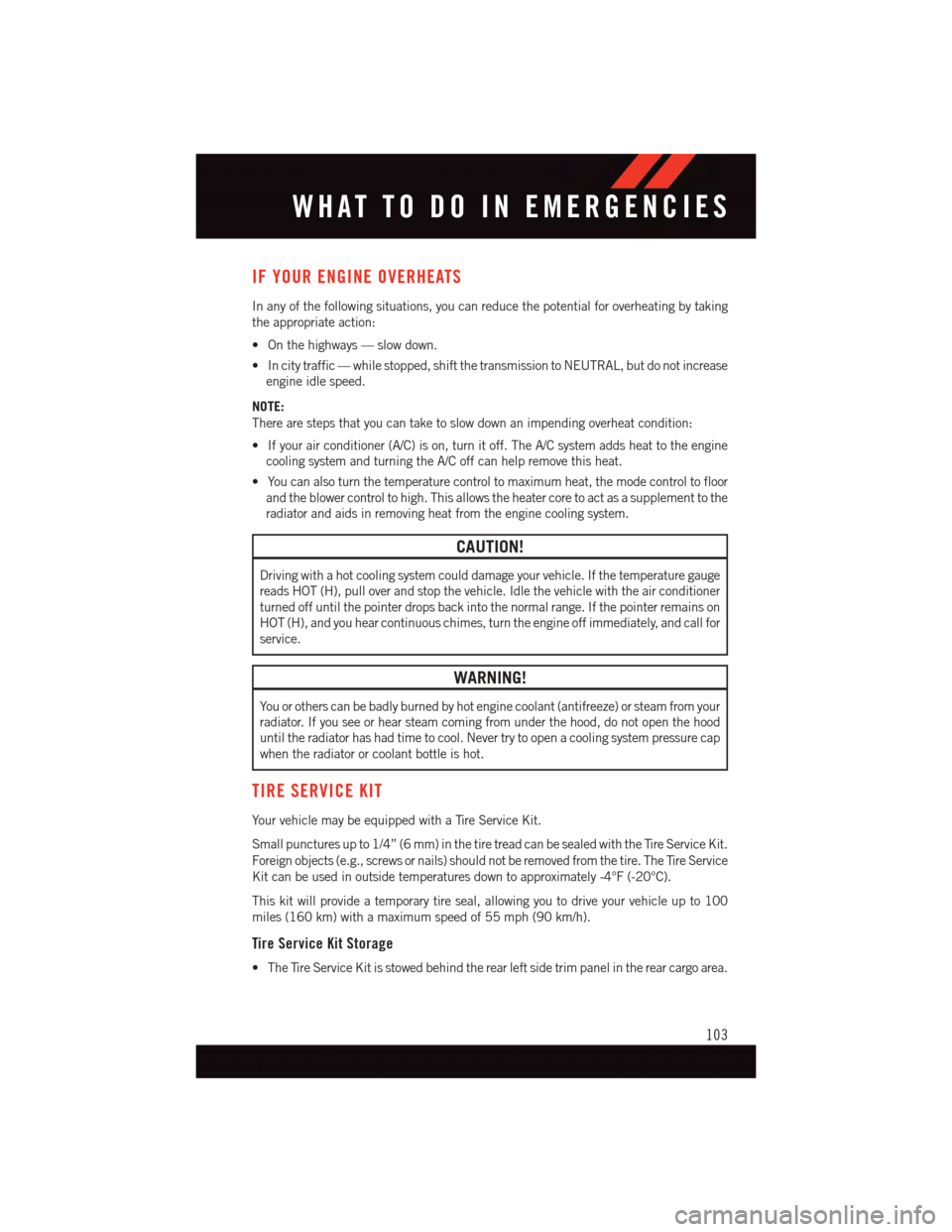
IF YOUR ENGINE OVERHEATS
In any of the following situations, you can reduce the potential for overheating by taking
the appropriate action:
•Onthehighways—slowdown.
•Incitytraffic—whilestopped,shiftthetransmissiontoNEUTRAL,butdonotincrease
engine idle speed.
NOTE:
There are steps that you can take to slow down an impending overheat condition:
•Ifyourairconditioner(A/C)ison,turnitoff.TheA/Csystemaddsheattotheengine
cooling system and turning the A/C off can help remove this heat.
•Youcanalsoturnthetemperaturecontroltomaximumheat,themodecontroltofloor
and the blower control to high. This allows the heater core to act as a supplement to the
radiator and aids in removing heat from the engine cooling system.
CAUTION!
Driving with a hot cooling system could damage your vehicle. If the temperature gauge
reads HOT (H), pull over and stop the vehicle. Idle the vehicle with the air conditioner
turned off until the pointer drops back into the normal range. If the pointer remains on
HOT (H), and you hear continuous chimes, turn the engine off immediately, and call for
service.
WARNING!
Yo u o r o t h e r s c a n b e b a d l y b u r n e d b y h o t e n g i n e c o o l a n t ( a n t i f r e e z e ) o r s t e a m f r o m y o u r
radiator. If you see or hear steam coming from under the hood, do not open the hood
until the radiator has had time to cool. Never try to open a cooling system pressure cap
when the radiator or coolant bottle is hot.
TIRE SERVICE KIT
Yo u r v e h i c l e m a y b e e q u i p p e d w i t h a Ti r e S e r v i c e K i t .
Small punctures up to 1/4” (6 mm) in the tire tread can be sealed with the Tire Service Kit.
Foreign objects (e.g., screws or nails) should not be removed from the tire. The Tire Service
Kit can be used in outside temperatures down to approximately -4°F (-20°C).
This kit will provide a temporary tire seal, allowing you to drive your vehicle up to 100
miles (160 km) with a maximum speed of 55 mph (90 km/h).
Tire Service Kit Storage
•TheTireServiceKitisstowedbehindtherearleftsidetrimpanelintherearcargoarea.
WHAT TO DO IN EMERGENCIES
103
Page 130 of 164
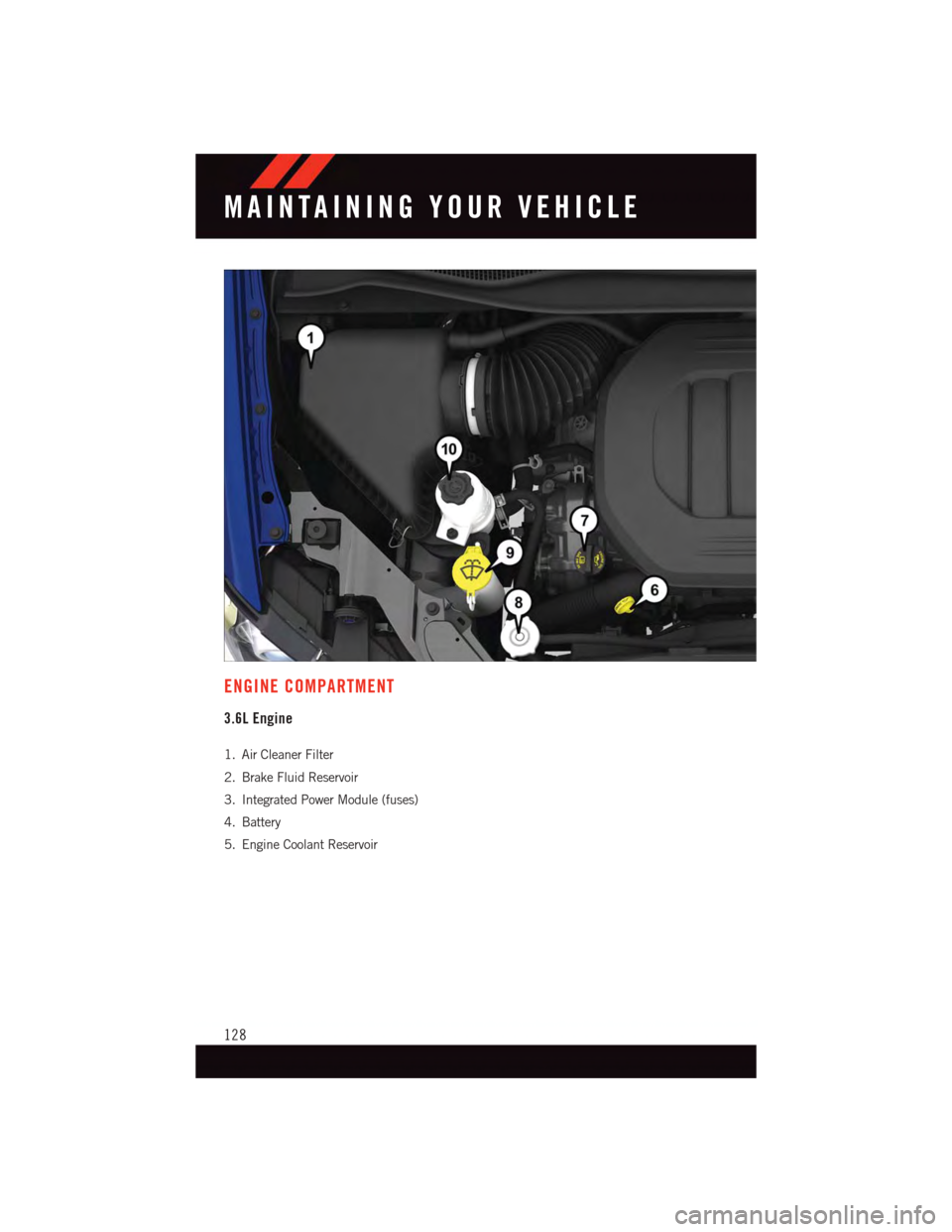
ENGINE COMPARTMENT
3.6L Engine
1. Air Cleaner Filter
2. Brake Fluid Reservoir
3. Integrated Power Module (fuses)
4. Battery
5. Engine Coolant Reservoir
MAINTAINING YOUR VEHICLE
128
Page 131 of 164
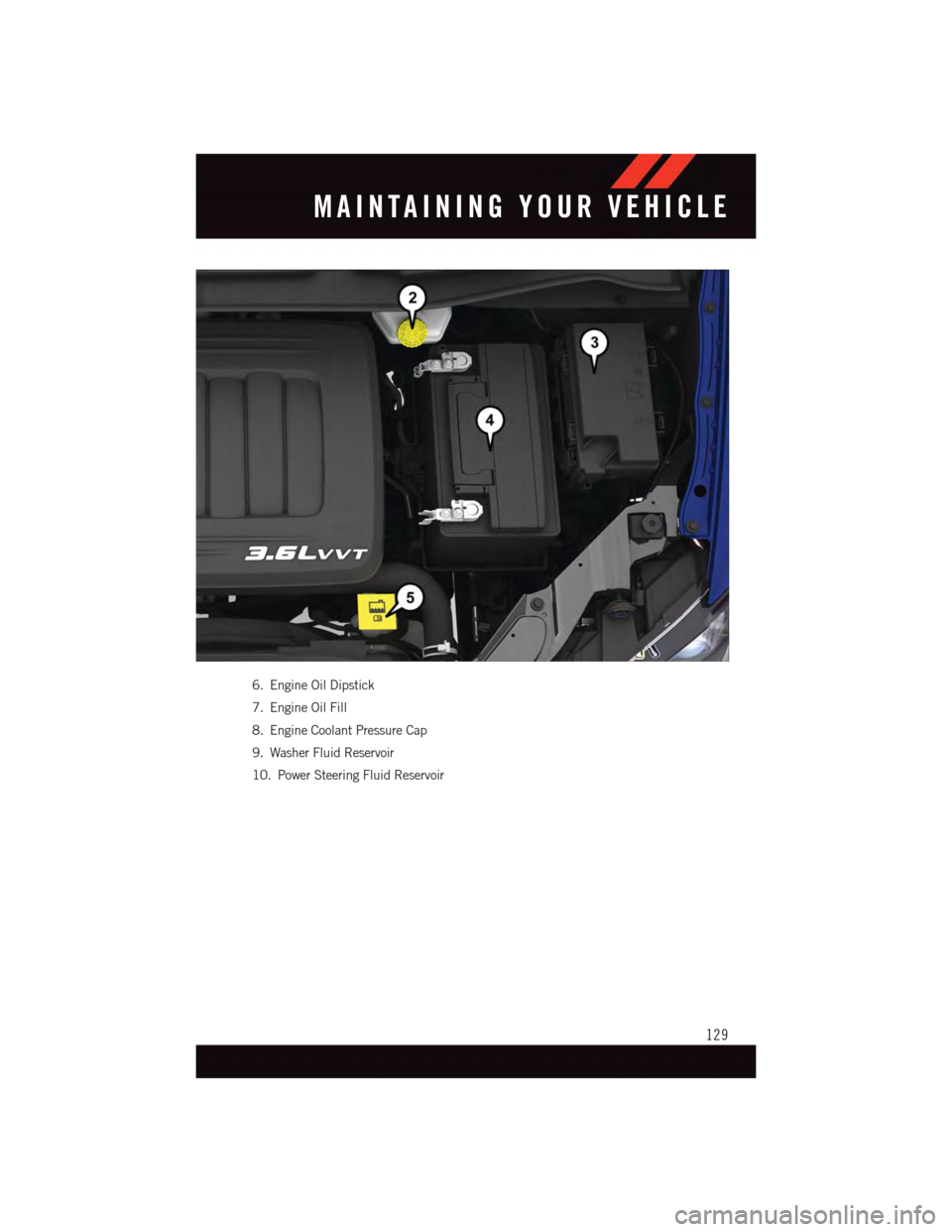
6. Engine Oil Dipstick
7. Engine Oil Fill
8. Engine Coolant Pressure Cap
9. Washer Fluid Reservoir
10. Power Steering Fluid Reservoir
MAINTAINING YOUR VEHICLE
129
Page 132 of 164
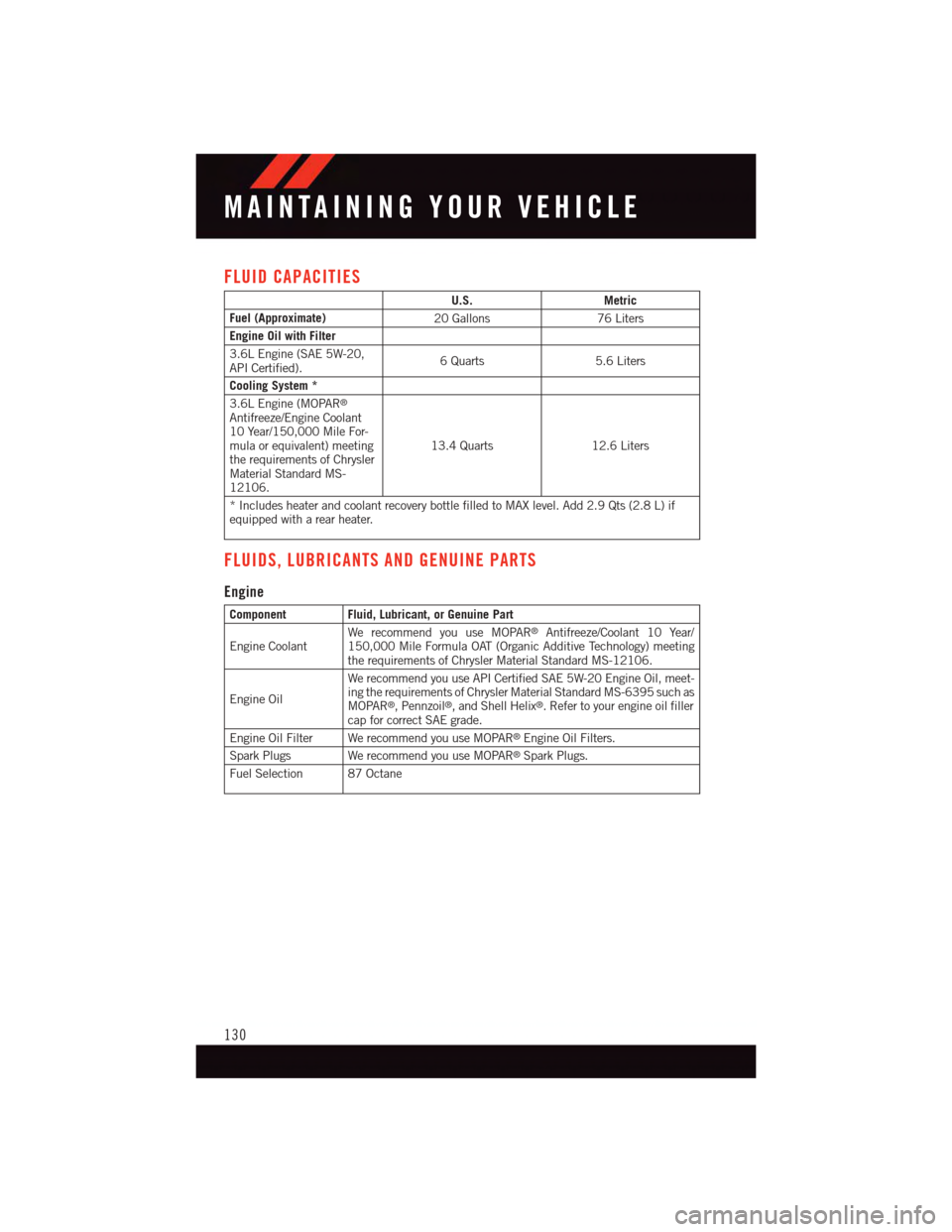
FLUID CAPACITIES
U.S.Metric
Fuel (Approximate)20 Gallons76 Liters
Engine Oil with Filter
3.6L Engine (SAE 5W-20,API Certified).6Quarts5.6 Liters
Cooling System *
3.6L Engine (MOPAR®
Antifreeze/Engine Coolant10 Year/150,000 Mile For-mula or equivalent) meetingthe requirements of ChryslerMaterial Standard MS-12106.
13.4 Quarts12.6 Liters
*IncludesheaterandcoolantrecoverybottlefilledtoMAXlevel.Add2.9Qts(2.8L)ifequipped with a rear heater.
FLUIDS, LUBRICANTS AND GENUINE PARTS
Engine
Component Fluid, Lubricant, or Genuine Part
Engine CoolantWe recommend you use MOPAR®Antifreeze/Coolant 10 Year/150,000 Mile Formula OAT (Organic Additive Technology) meetingthe requirements of Chrysler Material Standard MS-12106.
Engine Oil
We recommend you use API Certified SAE 5W-20 Engine Oil, meet-ing the requirements of Chrysler Material Standard MS-6395 such asMOPAR®,Pennzoil®,andShellHelix®.Refertoyourengineoilfillercap for correct SAE grade.
Engine Oil Filter We recommend you use MOPAR®Engine Oil Filters.
Spark Plugs We recommend you use MOPAR®Spark Plugs.
Fuel Selection 87 Octane
MAINTAINING YOUR VEHICLE
130
Page 133 of 164
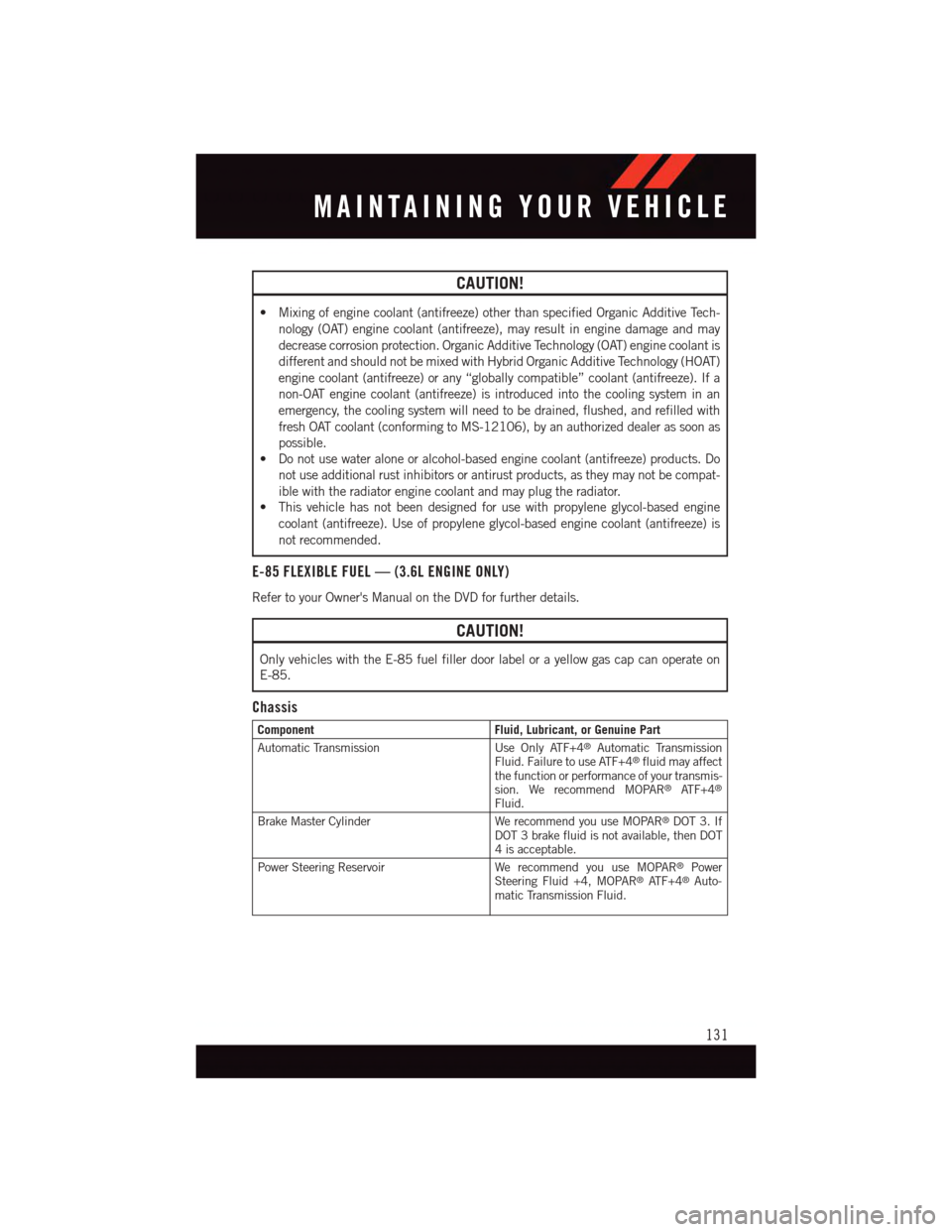
CAUTION!
•Mixingofenginecoolant(antifreeze)otherthanspecifiedOrganicAdditiveTech-
nology (OAT) engine coolant (antifreeze), may result in engine damage and may
decrease corrosion protection. Organic Additive Technology (OAT) engine coolant is
different and should not be mixed with Hybrid Organic Additive Technology (HOAT)
engine coolant (antifreeze) or any “globally compatible” coolant (antifreeze). If a
non-OAT engine coolant (antifreeze) is introduced into the cooling system in an
emergency, the cooling system will need to be drained, flushed, and refilled with
fresh OAT coolant (conforming to MS-12106), by an authorized dealer as soon as
possible.
•Donotusewateraloneoralcohol-basedenginecoolant(antifreeze)products.Do
not use additional rust inhibitors or antirust products, as they may not be compat-
ible with the radiator engine coolant and may plug the radiator.
•Thisvehiclehasnotbeendesignedforusewithpropyleneglycol-basedengine
coolant (antifreeze). Use of propylene glycol-based engine coolant (antifreeze) is
not recommended.
E-85 FLEXIBLE FUEL — (3.6L ENGINE ONLY)
Refer to your Owner's Manual on the DVD for further details.
CAUTION!
Only vehicles with the E-85 fuel filler door label or a yellow gas cap can operate on
E-85.
Chassis
ComponentFluid, Lubricant, or Genuine Part
Automatic TransmissionUse Only ATF+4®Automatic TransmissionFluid. Failure to use ATF+4®fluid may affectthe function or performance of your transmis-sion. We recommend MOPAR®AT F + 4®
Fluid.
Brake Master CylinderWe recommend you use MOPAR®DOT 3. IfDOT 3 brake fluid is not available, then DOT4isacceptable.
Power Steering Reservoir We recommend you use MOPAR®PowerSteering Fluid +4, MOPAR®AT F + 4®Auto-matic Transmission Fluid.
MAINTAINING YOUR VEHICLE
131
Page 134 of 164
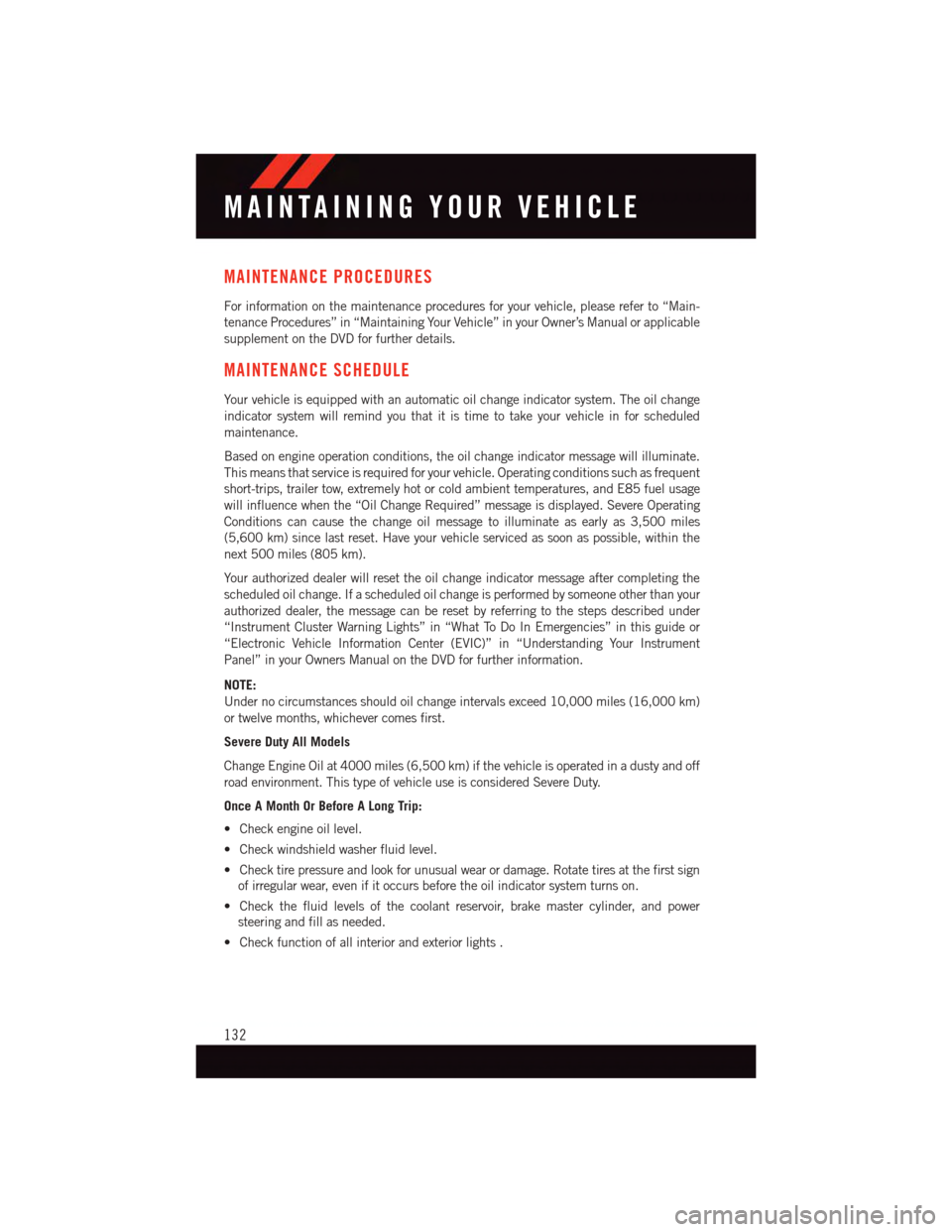
MAINTENANCE PROCEDURES
For information on the maintenance procedures for your vehicle, please refer to “Main-
tenance Procedures” in “Maintaining Your Vehicle” in your Owner’s Manual or applicable
supplement on the DVD for further details.
MAINTENANCE SCHEDULE
Yo u r v e h i c l e i s e q u i p p e d w i t h a n a u t o m a t i c o i l c h a n g e i n d i c a t o r s y s t e m . T h e o i l c h a n g e
indicator system will remind you that it is time to take your vehicle in for scheduled
maintenance.
Based on engine operation conditions, the oil change indicator message will illuminate.
This means that service is required for your vehicle. Operating conditions such as frequent
short-trips, trailer tow, extremely hot or cold ambient temperatures, and E85 fuel usage
will influence when the “Oil Change Required” message is displayed. Severe Operating
Conditions can cause the change oil message to illuminate as early as 3,500 miles
(5,600 km) since last reset. Have your vehicle serviced as soon as possible, within the
next 500 miles (805 km).
Yo u r a u t h o r i z e d d e a l e r w i l l r e s e t t h e o i l c h a n g e i n d i c a t o r m e s s a g e a f t e r c o m p l e t i n g t h e
scheduled oil change. If a scheduled oil change is performed by someone other than your
authorized dealer, the message can be reset by referring to the steps described under
“Instrument Cluster Warning Lights” in “What To Do In Emergencies” in this guide or
“Electronic Vehicle Information Center (EVIC)” in “Understanding Your Instrument
Panel” in your Owners Manual on the DVD for further information.
NOTE:
Under no circumstances should oil change intervals exceed 10,000 miles (16,000 km)
or twelve months, whichever comes first.
Severe Duty All Models
Change Engine Oil at 4000 miles (6,500 km) if the vehicle is operated in a dusty and off
road environment. This type of vehicle use is considered Severe Duty.
Once A Month Or Before A Long Trip:
•Checkengineoillevel.
•Checkwindshieldwasherfluidlevel.
•Checktirepressureandlookforunusualwearordamage.Rotatetiresatthefirstsign
of irregular wear, even if it occurs before the oil indicator system turns on.
•Checkthefluidlevelsofthecoolantreservoir,brakemastercylinder,andpower
steering and fill as needed.
•Checkfunctionofallinteriorandexteriorlights.
MAINTAINING YOUR VEHICLE
132
Page 136 of 164
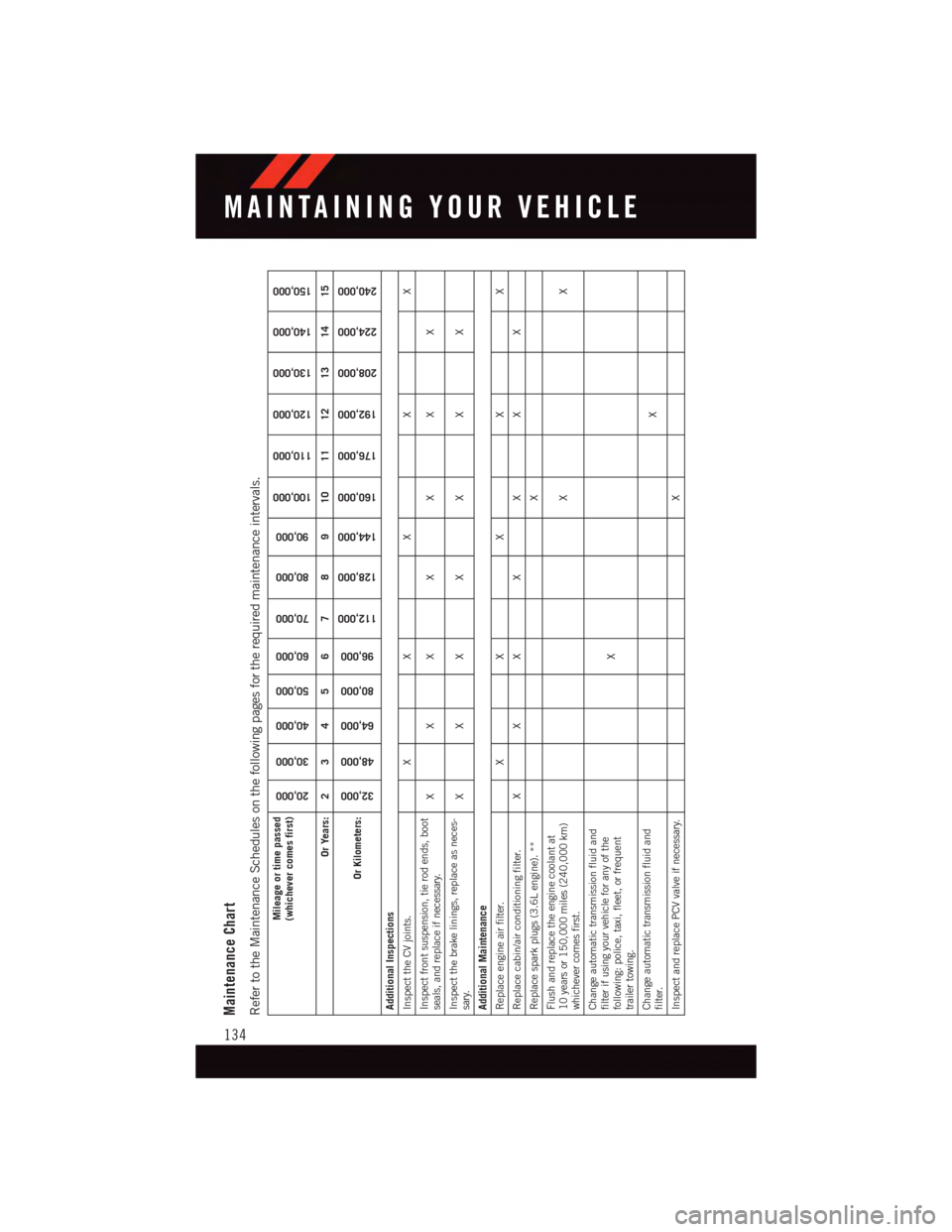
Maintenance ChartRefer to the Maintenance Schedules on the following pages for the required maintenance intervals.
Mileage or time passed(whichever comes first)
20,000
30,000
40,000
50,000
60,000
70,000
80,000
90,000
100,000
110,000
120,000
130,000
140,000
150,000
Or Years: 2 3 4 5 6 7 8 9 10 11 12 13 14 15
Or Kilometers:
32,000
48,000
64,000
80,000
96,000
112,000
128,000
144,000
160,000
176,000
192,000
208,000
224,000
240,000
Additional InspectionsInspect the CV joints. X X X X XInspect front suspension, tie rod ends, bootseals, and replace if necessary.
XXX X X X X
Inspect the brake linings, replace as neces-sary.
XXX X X X X
Additional MaintenanceReplace engine air filter. X X X X XReplace cabin/air conditioning filter. X X X X X X XReplace spark plugs (3.6L engine). ** XFlush and replace the engine coolant at10 years or 150,000 miles (240,000 km)whichever comes first.
XX
Change automatic transmission fluid andfilter if using your vehicle for any of thefollowing: police, taxi, fleet, or frequenttrailer towing.
X
Change automatic transmission fluid andfilter.
X
Inspect and replace PCV valve if necessary.
X
MAINTAINING YOUR VEHICLE
134
Page 154 of 164
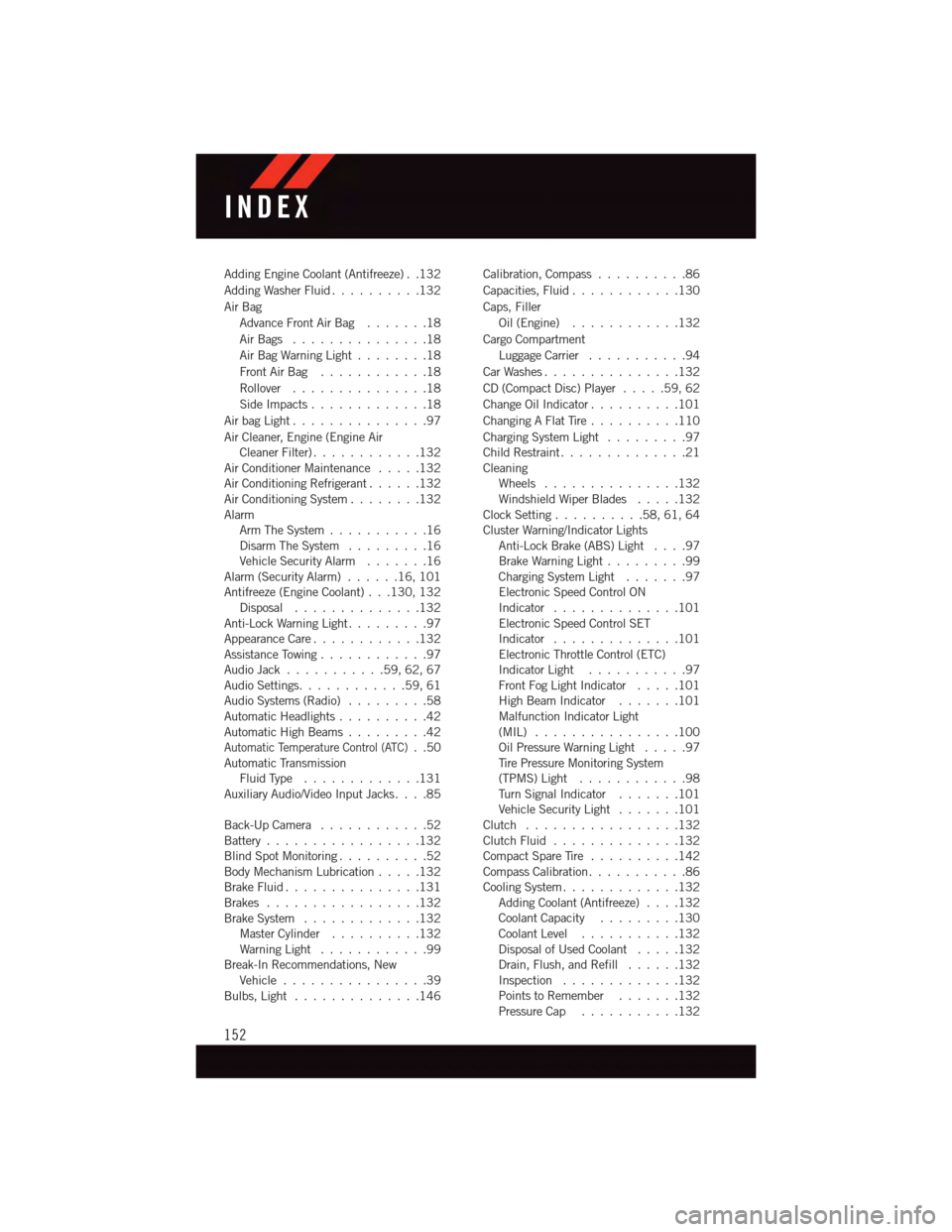
Adding Engine Coolant (Antifreeze) . .132
Adding Washer Fluid..........132
Air Bag
Advance Front Air Bag.......18
Air Bags . . . . . . . . . . . . . . .18
Air Bag Warning Light . . . . . . . .18
Front Air Bag . . . . . . . . . . . .18
Rollover . . . . . . . . . . . . . . .18
Side Impacts.............18
Air bag Light . . . . . . . . . . . . . . .97
Air Cleaner, Engine (Engine AirCleaner Filter)............132Air Conditioner Maintenance.....132Air Conditioning Refrigerant......132Air Conditioning System........132AlarmArm The System...........16Disarm The System.........16Vehicle Security Alarm.......16Alarm (Security Alarm)......16,101Antifreeze (Engine Coolant) . . .130, 132Disposal . . . . . . . . . . . . . .132Anti-Lock Warning Light.........97Appearance Care............132Assistance Towing............97Audio Jack...........59,62,67Audio Settings............59,61Audio Systems (Radio).........58Automatic Headlights..........42Automatic High Beams.........42
Automatic Temperature Control (ATC)..50Automatic TransmissionFluid Type . . . . . . . . . . . . .131Auxiliary Audio/Video Input Jacks....85
Back-Up Camera............52Battery.................132Blind Spot Monitoring..........52Body Mechanism Lubrication.....132Brake Fluid . . . . . . . . . . . . . . .131Brakes . . . . . . . . . . . . . . . . .132Brake System.............132Master Cylinder..........132Warning Light . . . . . . . . . . . .99Break-In Recommendations, NewVehicle . . . . . . . . . . . . . . . .39Bulbs, Light . . . . . . . . . . . . . .146
Calibration, Compass..........86
Capacities, Fluid............130
Caps, Filler
Oil (Engine)............132
Cargo Compartment
Luggage Carrier...........94
Car Washes . . . . . . . . . . . . . . .132
CD (Compact Disc) Player.....59,62
Change Oil Indicator..........101
Changing A Flat Tire..........110
Charging System Light.........97Child Restraint..............21CleaningWheels...............132Windshield Wiper Blades.....132Clock Setting..........58,61,64Cluster Warning/Indicator LightsAnti-Lock Brake (ABS) Light....97Brake Warning Light . . . . . . . . .99Charging System Light.......97Electronic Speed Control ONIndicator . . . . . . . . . . . . . .101Electronic Speed Control SETIndicator . . . . . . . . . . . . . .101Electronic Throttle Control (ETC)Indicator Light . . . . . . . . . . .97Front Fog Light Indicator . . . . .101High Beam Indicator.......101Malfunction Indicator Light(MIL) . . . . . . . . . . . . . . . .100Oil Pressure Warning Light . . . . .97Ti r e P r e s s u r e M o n i t o r i n g S y s t e m(TPMS) Light............98Tu r n S i g n a l I n d i c a t o r.......101Vehicle Security Light.......101Clutch . . . . . . . . . . . . . . . . .132Clutch Fluid . . . . . . . . . . . . . .132Compact Spare Tire..........142Compass Calibration...........86Cooling System . . . . . . . . . . . . .132Adding Coolant (Antifreeze)....132Coolant Capacity.........130Coolant Level...........132Disposal of Used Coolant.....132Drain, Flush, and Refill......132Inspection . . . . . . . . . . . . .132Points to Remember.......132Pressure Cap . . . . . . . . . . .132
INDEX
152
Page 155 of 164
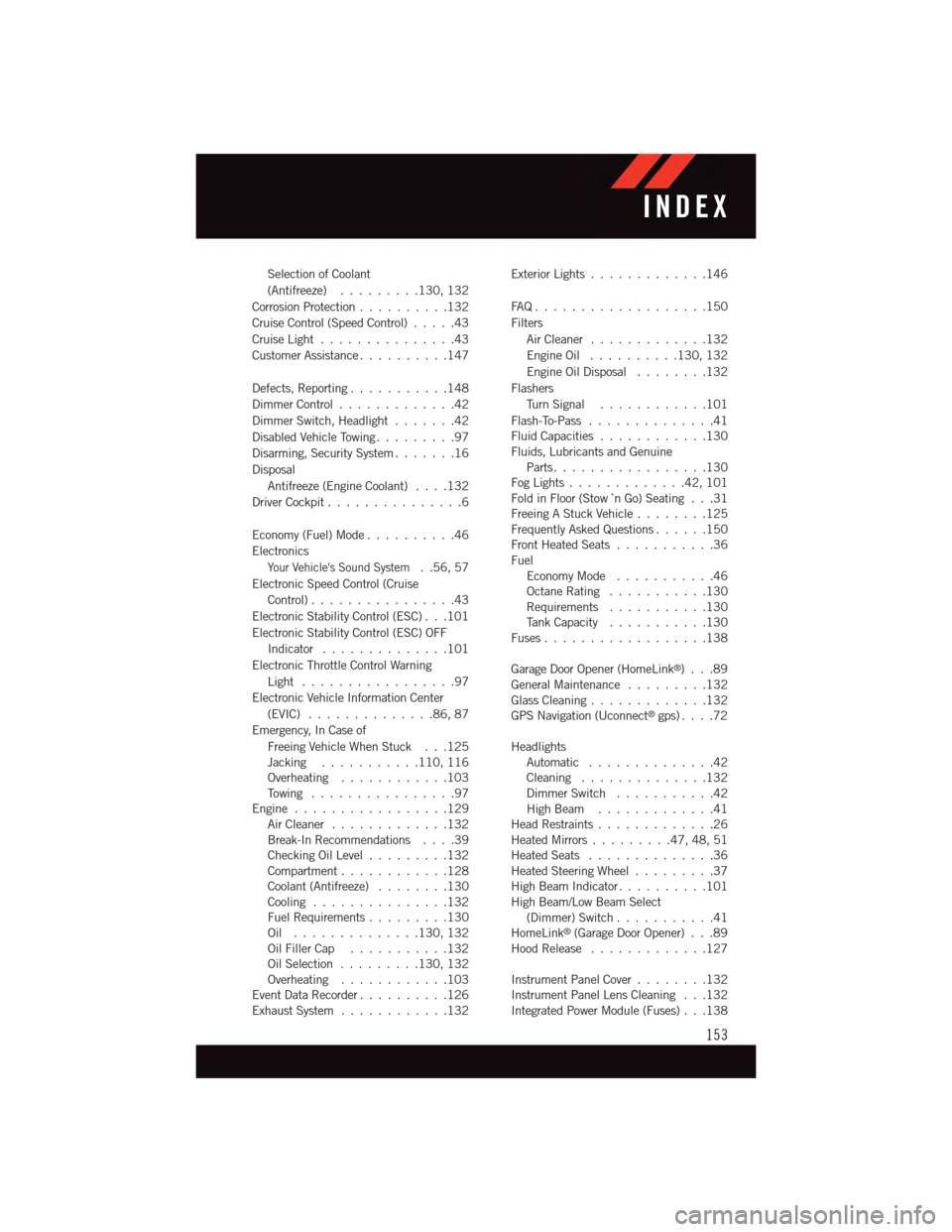
Selection of Coolant
(Antifreeze).........130, 132
Corrosion Protection..........132
Cruise Control (Speed Control).....43
Cruise Light . . . . . . . . . . . . . . .43
Customer Assistance..........147
Defects, Reporting...........148
Dimmer Control.............42
Dimmer Switch, Headlight.......42
Disabled Vehicle Towing . . . . . . . . .97
Disarming, Security System.......16
Disposal
Antifreeze (Engine Coolant)....132
Driver Cockpit...............6
Economy (Fuel) Mode..........46
Electronics
Yo u r Ve h i c l e ' s S o u n d S y s t e m..56,57
Electronic Speed Control (Cruise
Control) . . . . . . . . . . . . . . . .43
Electronic Stability Control (ESC) . . .101
Electronic Stability Control (ESC) OFF
Indicator . . . . . . . . . . . . . .101
Electronic Throttle Control Warning
Light . . . . . . . . . . . . . . . . .97
Electronic Vehicle Information Center
(EVIC) . . . . . . . . . . . . . .86, 87
Emergency, In Case of
Freeing Vehicle When Stuck . . .125Jacking . . . . . . . . . . .110, 116Overheating . . . . . . . . . . . .103To w i n g . . . . . . . . . . . . . . . . 9 7Engine . . . . . . . . . . . . . . . . .129Air Cleaner.............132Break-In Recommendations....39Checking Oil Level.........132Compartment............128Coolant (Antifreeze)........130Cooling . . . . . . . . . . . . . . .132Fuel Requirements.........130Oil . . . . . . . . . . . . . .130, 132Oil Filler Cap...........132Oil Selection . . . . . . . . .130, 132Overheating . . . . . . . . . . . .103Event Data Recorder..........126Exhaust System............132
Exterior Lights . . . . . . . . . . . . .146
FA Q . . . . . . . . . . . . . . . . . . . 1 5 0
Filters
Air Cleaner . . . . . . . . . . . . .132
Engine Oil..........130, 132
Engine Oil Disposal........132
Flashers
Tu r n S i g n a l............101
Flash-To-Pass..............41Fluid Capacities............130Fluids, Lubricants and GenuineParts . . . . . . . . . . . . . . . . .130Fog Lights . . . . . . . . . . . . .42, 101Fold in Floor (Stow `n Go) Seating . . .31Freeing A Stuck Vehicle . . . . . . . .125Frequently Asked Questions......150Front Heated Seats...........36FuelEconomy Mode...........46Octane Rating . . . . . . . . . . .130Requirements...........130Ta n k C a p a c i t y...........130Fuses . . . . . . . . . . . . . . . . . .138
Garage Door Opener (HomeLink®)...89General Maintenance.........132Glass Cleaning.............132GPS Navigation (Uconnect®gps)....72
HeadlightsAutomatic . . . . . . . . . . . . . .42Cleaning..............132Dimmer Switch...........42High Beam.............41Head Restraints.............26Heated Mirrors.........47,48,51Heated Seats..............36Heated Steering Wheel.........37High Beam Indicator..........101High Beam/Low Beam Select(Dimmer) Switch...........41HomeLink®(Garage Door Opener) . . .89Hood Release.............127
Instrument Panel Cover........132Instrument Panel Lens Cleaning . . .132Integrated Power Module (Fuses) . . .138
INDEX
153